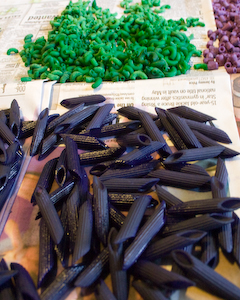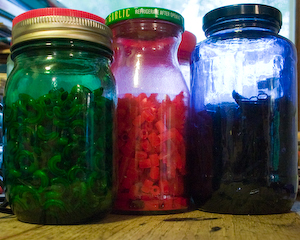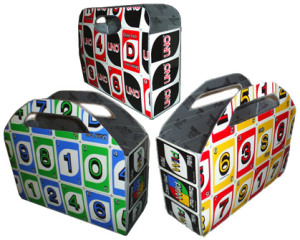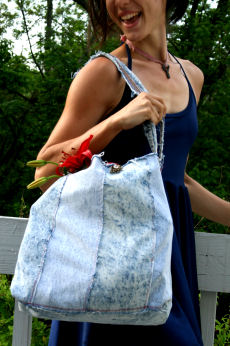
It’s a bit of a random craft, sure–perhaps a little church camp, perhaps a little preschool.
But your church camp and your preschool I’m sure didn’t have the same standards of artistic quality that I do. When I say that I’m going to show you how to dye pasta, I sure don’t mean that you can dye it some pale color that’s all uneven, anyway, and looks like something a three-year-old should be stringing on elastic cord.
I’m talking about how to dye pasta that POPS. I’m talking about bright colors, jewel tones, gorgeous shades of emerald or hot pink that will inspire even you, you jaded crafter you.
Because you know there are some things you totally want to make with this beautiful dried pasta. A mosaic? Some biodegradable jewelry? a chandelier to hang in the kitchen?
How to Dye Pasta
You will need:
+ Dried pasta in whatever sizes and shapes you desire. Here’s where your Green Crafting Manifesto kicks in. Do you buy the cheapest pasta available since you won’t be eating it, or do you buy organic, even though you won’t be eating it, in consideration for the workers and the environment? We’re poor, so we bought the cheap junk. You buy whatever feels right to you.
+ Liquid food coloring. NOT the nice professional-quality gel food coloring that you paid all that money for–you can use that in your play dough, actually, but for Easter egg dyeing and dried pasta crafts, stick with those little squeeze bottles of liquid dye. And the neon colors they sell? Are awesome.
+ Old jars to contain the dried pasta. We use an assortment of old spaghetti sauce jars, jam jars, and peanut butter jars. Need to de-stink those jars before you get crafty? Here’s how!
+ Rubbing alcohol. I’m not in love with the need for rubbing alcohol here, since I do this project with my girls and rubbing alcohol is neither particularly green nor particularly safe when consumed, and when what you’re doing is making food look pretty, that’s something to consider. But it is a non-water-based solvent that will keep the dye liquid yet not dissolve the pasta, and I can’t think of another solvent with those same qualities.
+ Lots of newspaper or dish towels.

1. Fill each jar about halfway with dried pasta. Not that you care, but when I do this project with my girls, this is an exercise for them in estimation.
2. Squeeze in as much dye as you want into the jar.
3. Pour only enough rubbing alcohol into the jar to just cover the bottom.
4. Screw the lids tightly onto all the jars.
5. Shake really well.
6. Leave the jars out on the table all day, because they need to be shaken off and on–whenever someone walks by, have them shake a jar or two.

7. Before you go to bed, lay out a very thick layer of newspapers or dishtowels on a table or countertop.
8. Spread out all the pasta in a thin layer to dry overnight.
Do NOT eat this pasta, right? I’m telling you, though, it looks amazing. When my daughters and I were making this one afternoon at my parents’ house, my grandfather AND my mother each walked by and, without asking permission, popped one of these pastas into their mouths. My daughters looked at them like they were nuts, and I was all, “It reeks of rubbing alcohol in here! Does it LOOK like we’re making something to eat?”
But yeah, that’s my family for you.










Pingback: How to Dye Dried Pasta in Bright, Happy Colors - Zidee.com
Well, you *could* use cheap strong vodka instead of the rubbing alcohol. Then it would technically be edible and marginally less harmful to the skin.
Interesting…that turns it into a whole different kind of craft–something to put at the bottom of a fancy shot, perhaps? I don’t think the rubbing alcohol we use for our pasta has ever affected our skin, though. After it air-dries, even the smell evaporates.
This looks GREAT. Question: if we’re making a mosaic, how can we stop ants from eating the finished product?
Couldn’t you use drinking alcohol such as vodka instead of rubbing alcohol? Then it would be edible. The odor doesn’t last too long either way. 🙂
@ CountryLady…. You are funny. I love your thinking. The question is, does it work?
I can’t imagine why vodka wouldn’t work–lord knows it’s got enough alcohol content! Now you just have to ask yourself: Am I the kind of person who has rubbing alcohol on hand, or am I the kind of person who has vodka on hand? I know which kind of person I am, and I kinda wish I was the other kind…
Would ants eat something saturated in alcohol? And if they would, would this serve as an effective pesticide? Otherwise, I’m thinking spray sealant.
all this talk of vodka, i’m wondering if you ladies have some very stressful children haha. VINEGAR works just great so you know…
Vinegar wouldn’t have come to my mind as a possibility, actually. Since it’s an acid, I would think that it would eat away at the pasta while it soaks, or otherwise soften it. Alcohol is always a good choice as a solvent for a permanent dye–yay, vodka!
Pingback: Weekend Activity – Colored Pasta | Intentionally yours, Mom
I made this for my preschoolers and it was awesome. Thanks!
Pingback: How-to: Make Your Own Organic Colored Sanding Sugar
I wondered about the safety of the rubbing alcohol (fumes, someone tasting the pasta, etc.) because I’d seen this recommendation on other sites as well. I don’t drink but the idea of vodka actually appeals to me more in this sense because I’d feel that it was a tad safer, even after dry, and would not have the noxious fumes?? My question is, has anyone had success with vodka, or any other liquid, other than the rubbing alcohol? Thanks!! 🙂
I read somewhere of using hand sanitizer, which is alcohol based, but more likely to have on hand maybe? Have not tried, but seems like it would work…
Pingback: USING YOUR NOODLE… « READ ALL ABOUT IT! News from the Ossining Public Library Children’s Room
So, I am trying to dye my pasta and it is just kind of sad and drab and spotted. What am I doing wrong? Does the type (%) of rubbing alcohol make a difference?
You may still need to give it more time. We have these in the dye jars all day when we make these, shaking them whenever someone walks by and thinks of it. There’s no reason why the pasta should end up spotty, except that it’s under-saturated. The same could be said for why it might be drab–you can be really generous with the liquid food coloring for these.
I’ve used vinegar and it’s fine. Pasta doesn’t come out as hard but I always have vinegar on hand for projects. Color holds nicely.
Pingback: Crafting a Green World | The home for green crafts and tutorials!